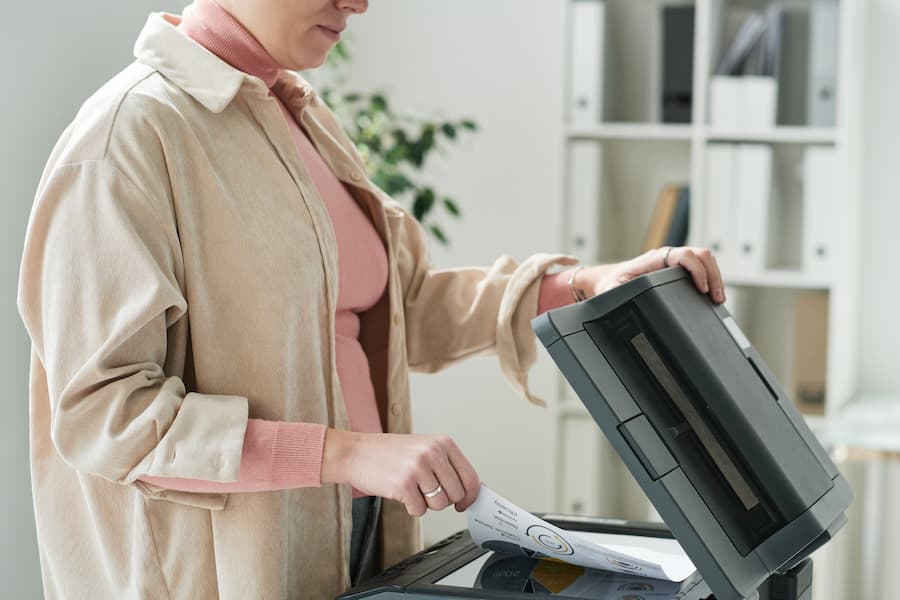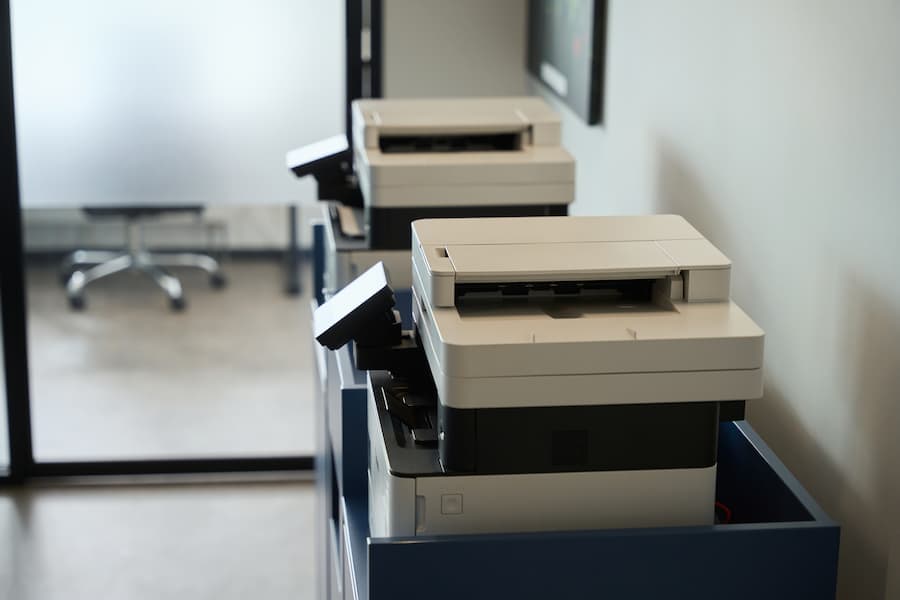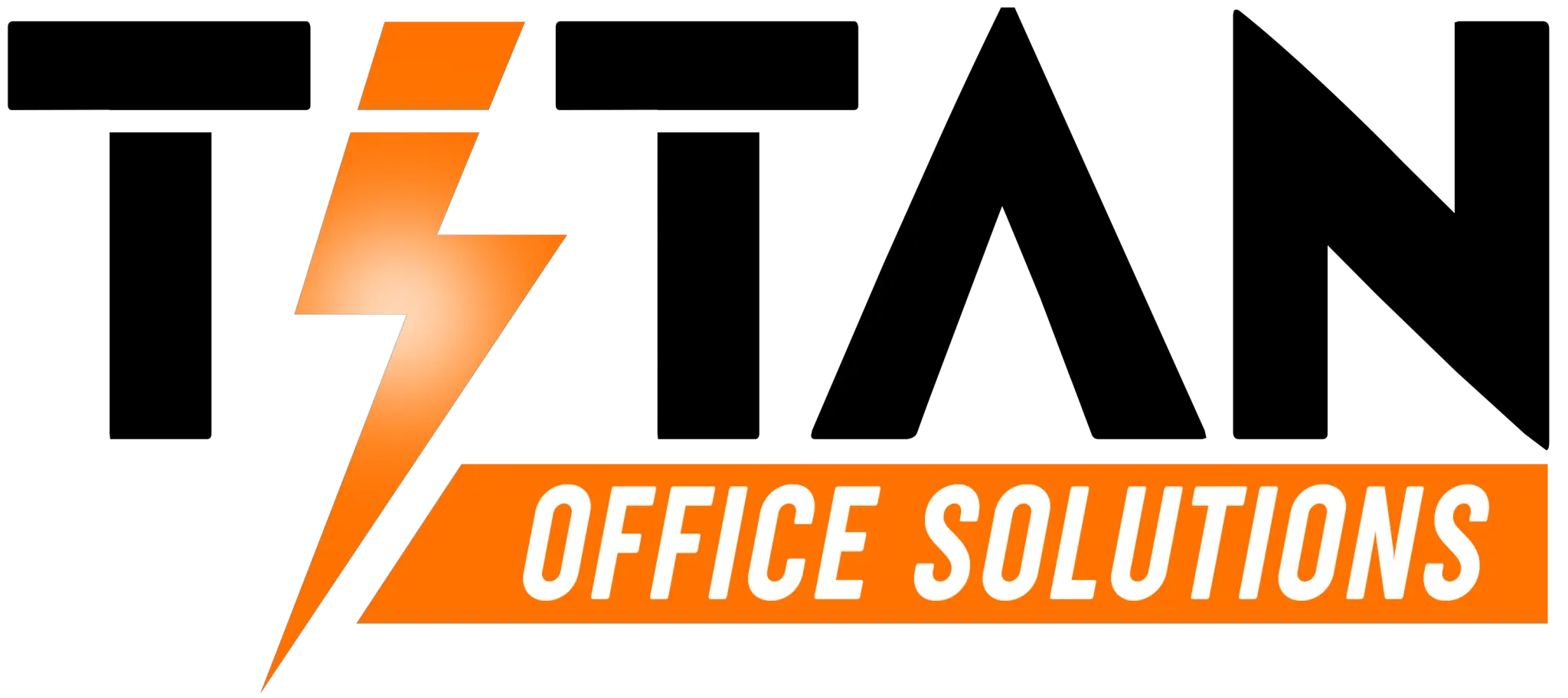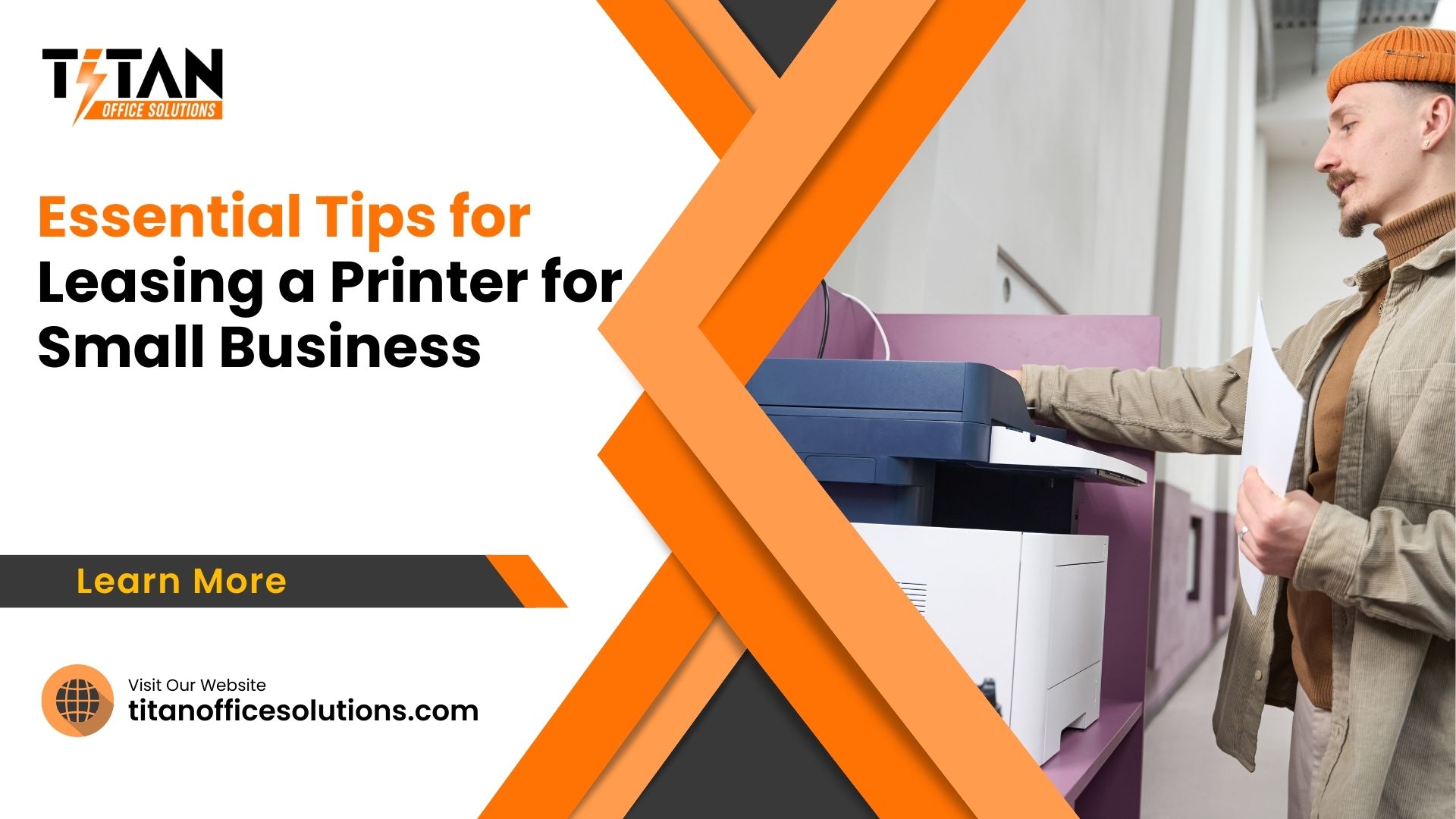Leasing a Printer for Small Business
Leasing a printer is an increasingly popular option for small businesses aiming to balance operational efficiency and cost management. Unlike purchasing, leasing allows businesses to acquire high-quality office equipment without a substantial upfront investment.
Having reliable and up-to-date office equipment is crucial for maintaining productivity and competitive edge. This article explores the essential aspects of leasing a printer, providing detailed insights to help small businesses make informed decisions.

Why Lease a Printer?
Benefits of Office Printer Leasing Over Buying
Leasing a printer offers several advantages over outright purchasing, particularly for small businesses that need to manage their cash flow carefully. One of the primary benefits is cost savings. When you lease, there is no need for a large upfront payment, which can be a significant financial burden, especially for startups or businesses with limited capital. Instead, leasing allows you to spread the cost over regular monthly payments, making it easier to budget and plan financially.
Furthermore, leasing provides the flexibility to upgrade your equipment as technology evolves. With rapid advancements in printer technology, having the latest equipment can enhance productivity and efficiency. Leasing agreements often include options to upgrade to newer models, ensuring your business always has access to cutting-edge technology without the need for additional investment.
Another advantage is the inclusion of managed print services. These services typically cover maintenance, repairs, and supplies, reducing the responsibility on your IT staff and ensuring that your printers are always in optimal condition. This can lead to significant savings in terms of time and money spent on upkeep.
Flexibility and Upgrades
One of the most compelling reasons to lease a printer is the flexibility it offers. As your business grows and evolves, your printing needs may change. Leasing allows you to adapt to these changes more easily compared to owning equipment outright. You can scale up or down, switch to different types of printers, or upgrade to more advanced models as required.
For instance, if your business experiences a temporary increase in printing volume, you can adjust your lease to include additional or higher-capacity printers. Conversely, if your needs decrease, you can downsize your fleet at the end of the lease term. This adaptability helps ensure that your office equipment always meets your current business requirements without unnecessary expenses.
Managed Print Services
Managed print services (MPS) are a significant benefit often included in leasing agreements. MPS providers offer comprehensive management of your printing needs, from supplying consumables like toner and paper to performing regular maintenance and repairs. This holistic approach ensures that your printers are always operational, reducing downtime and improving productivity.
By outsourcing the management of your printing infrastructure to an MPS provider, you can free up your IT staff to focus on more strategic tasks. MPS providers also offer monitoring and reporting tools that help you understand your printing usage, identify inefficiencies, and optimize your printing processes. This can lead to cost savings, improved security, and a more environmentally friendly printing operation.
Understanding the Costs of Office Printer Leasing
Breakdown of Costs
Leasing a printer involves various costs that you need to consider to understand the total financial commitment. The primary cost is the monthly lease payment, which is determined by factors such as the type of printer, lease duration, and any additional services included. This predictable monthly expense can make budgeting easier compared to the fluctuating costs associated with owning and maintaining a printer.
In addition to the lease payment, you may incur additional costs for consumables like toner, paper, and maintenance services. Some leasing agreements include these costs as part of an all-inclusive package, while others may charge them separately. It’s essential to understand what is covered under your lease agreement to avoid unexpected expenses.
Comparing the total cost of leasing to the cost of buying a printer is crucial for making an informed decision. Leasing spreads the cost over time, which can be advantageous for cash flow management, but it may result in a higher total cost over the long term.
Comparing Copier Lease vs. Buying Costs
When deciding whether to lease or buy a printer, it’s important to consider the total cost of ownership (TCO). The TCO includes not only the initial purchase price but also ongoing expenses such as maintenance, repairs, and consumables. Leasing often appears more expensive in the long run when looking solely at monthly payments, but the inclusion of services and the ability to upgrade equipment can make it a more cost-effective option overall.
Tax benefits are another consideration. Lease payments can often be deducted as business expenses, providing a tax advantage. In contrast, purchasing a printer may require capital expenditure, which is depreciated over time. Understanding the tax implications of leasing versus buying can help you make a more financially advantageous decision.
How Leasing Impacts Cash Flow
Leasing a printer can significantly impact your business’s cash flow. The most immediate benefit is the elimination of a large upfront cost, which preserves your capital for other critical business needs. Regular monthly lease payments make it easier to predict and manage expenses, contributing to better financial planning and stability.
Leasing also allows you to allocate resources more effectively. Instead of tying up a substantial amount of money in purchasing equipment, you can invest in other areas that drive growth and profitability, such as marketing, research and development, or hiring new talent. This strategic allocation of resources can enhance your business’s overall performance and competitiveness.
Types of Printers & Copier Available for Lease
Multifunction Printers
Multifunction printers (MFPs) are a popular choice for small businesses due to their versatility and efficiency. An MFP combines printing, scanning, copying, and faxing capabilities into a single device, saving space and reducing the need for multiple machines. This all-in-one solution can streamline your office operations and improve productivity.

MFPs are available in various configurations, from basic models suitable for small offices to advanced units designed for high-volume printing environments. When leasing an MFP, consider the specific needs of your business, such as the volume of documents processed, required features, and the level of technical support provided by the leasing company.
Laser Printers
Laser printers are known for their speed, precision, and cost-effectiveness, making them ideal for businesses that require high-quality, high-volume printing. These printers use laser technology to produce sharp text and graphics, which is particularly beneficial for producing professional documents.
Leasing a laser printer can provide your business with access to advanced printing technology without the significant upfront cost. When evaluating laser printers for lease, consider factors such as print speed, resolution, paper handling capabilities, and total cost of ownership. Laser printers are available in monochrome and color models, with the choice depending on your specific business needs.
Color and Monochrome Printers
The choice between color and monochrome printers depends on your business’s specific printing requirements. Monochrome printers are generally more cost-effective and suitable for printing documents that don’t require color, such as invoices, reports, and text-heavy documents. They are typically faster and have lower operating costs compared to color printers.
Color printers, on the other hand, are essential for businesses that need to produce marketing materials, presentations, and other documents where color is important. While they tend to be more expensive to operate, leasing a color printer can mitigate some of these costs by spreading them over the lease term.
When deciding between color and monochrome printers, consider the types of documents you print most frequently and the importance of color in your business communications. Leasing agreements can be tailored to include the type of printer that best suits your needs, ensuring you get the most value from your investment.
Lease Agreements and Terms
Understanding Lease Contracts
A lease contract is a legally binding agreement that outlines the terms and conditions of leasing a printer. Key components of a lease agreement include the lease duration, monthly payment amount, included services, and any additional costs. It’s essential to thoroughly review and understand these terms to avoid any surprises during the lease term.
Typical lease periods range from 24 to 60 months, with longer leases often offering lower monthly payments. However, longer leases also mean committing to the same equipment for an extended period, which may not be ideal if your business’s needs change frequently.
End of Lease Options
At the end of the lease term, you typically have several options: renewing the lease, returning the equipment, or purchasing the printer. Each option has its own set of considerations. Renewing the lease can be advantageous if the equipment still meets your needs and you want to avoid the hassle of acquiring new printers.
Returning the equipment allows you to upgrade to newer models, while purchasing the printer can be a cost-effective solution if you anticipate continued use of the equipment without the need for further upgrades.
Pros and Cons of Leasing a Printer
Advantages of Leasing
Leasing a printer provides numerous advantages that can significantly benefit small businesses. One of the most notable advantages is access to high-end equipment without the substantial upfront cost. This allows businesses to utilize state-of-the-art technology that might otherwise be unaffordable. Advanced printers and copiers come with features that enhance productivity, such as faster printing speeds, higher-quality outputs, and multifunction capabilities, which are crucial for efficient office operations.
Another advantage is the inclusion of maintenance and support services. Most leasing agreements come with comprehensive service packages that cover routine maintenance, repairs, and even supplies like toner and paper. This not only ensures that your equipment is always in optimal working condition but also reduces the burden on your IT staff, allowing them to focus on other critical tasks. Additionally, these services help prevent downtime, which can be costly in terms of both time and money.
Leasing also offers significant flexibility. As technology evolves and your business needs change, leasing allows you to upgrade to newer models without the hassle of disposing of outdated equipment. This adaptability ensures that your business always has access to the latest technology, which can be a competitive advantage. Furthermore, leasing agreements can be tailored to fit your specific needs, whether you require short-term leases or longer commitments.
Disadvantages of Leasing
Despite the many advantages, leasing also has its downsides. One of the primary disadvantages is the long-term cost. While leasing spreads out the payments and reduces the initial financial burden, the total cost over the lease term can be higher than the cost of purchasing the equipment outright. This is especially true if you continue to lease for several years, as the cumulative payments can exceed the purchase price.
Another potential downside is the contractual restrictions. Leasing agreements often come with terms and conditions that may limit your flexibility. For example, you may be restricted in how you can use the equipment or face penalties for early termination of the lease. These restrictions can be a hindrance if your business needs change or if you find a better leasing deal elsewhere.
Furthermore, at the end of the lease term, you do not own the equipment. This means you will either need to renew the lease, lease new equipment, or purchase the leased equipment if you want to keep using it. Each of these options involves additional costs and considerations. Understanding these potential downsides is crucial for making an informed decision about whether leasing is the best option for your business.
Choosing the Right Leasing Company
Evaluating Leasing Companies
Selecting the right leasing company is a critical step in the leasing process. The reputation of the leasing company is one of the most important factors to consider. Look for companies with positive reviews and a strong track record in the industry. A reputable leasing company will be transparent about their terms and conditions, provide high-quality customer service, and be responsive to your needs.

Service offerings are another key consideration. Different leasing companies offer varying levels of service, so it’s important to choose one that aligns with your business requirements. Some companies provide all-inclusive packages that cover maintenance, repairs, and supplies, while others may charge extra for these services. Ensure that the company you choose can provide the level of support you need to keep your office equipment running smoothly.
Cost is also an important factor. Compare the leasing rates and terms offered by different companies to find the best deal. Be wary of hidden fees or charges that may not be apparent at first glance. It’s essential to understand the total cost of the lease, including any additional fees for maintenance, repairs, or supplies.
Questions to Ask Potential Providers
When evaluating potential leasing providers, it’s important to ask the right questions to ensure you make an informed decision. Some key questions include:
- What is included in the lease agreement? Understand what services and supplies are covered under the lease and what additional costs you may incur.
- What are the terms and conditions? Review the lease terms, including the duration, payment schedule, and any penalties for early termination.
- What are the end-of-lease options? Ask about your options at the end of the lease term, such as renewing the lease, purchasing the equipment, or upgrading to a newer model.
- What is the response time for maintenance and repairs? Ensure that the leasing company can provide prompt service to minimize downtime.
- Are there any hidden fees or charges? Clarify any potential additional costs to avoid unexpected expenses.
By asking these questions, you can better understand the leasing agreement and choose a provider that meets your business needs.
What People May Also Ask
What is the cost of leasing a printer?
The cost of leasing a printer varies depending on the type of printer, the lease duration, and the services included. Typically, leasing involves a fixed monthly payment that covers the use of the printer and may include maintenance, repairs, and supplies. This predictable monthly expense makes budgeting easier compared to the fluctuating costs of owning and maintaining a printer.
How does leasing a printer work?
Leasing a printer involves entering into an agreement with a leasing company to use the printer for a specified period. The agreement outlines the terms and conditions, including the monthly payment, lease duration, and services included. At the end of the lease term, you may have the option to renew the lease, return the printer, or purchase it.
Is leasing better than buying for small businesses?
Leasing can be a better option for small businesses that want to avoid large upfront costs, benefit from regular maintenance and support services, and have the flexibility to upgrade to newer models. However, the decision to lease or buy depends on your specific business needs, financial situation, and long-term plans.
What are the end-of-lease options?
At the end of the lease term, you typically have several options: renewing the lease, returning the equipment, or purchasing the printer. Each option has its own set of considerations and costs. Understanding these options can help you plan for the end of the lease term and make the best decision for your business.
Conclusion
Leasing a printer offers numerous benefits for small businesses, including cost savings, flexibility, and access to the latest technology. By understanding the costs involved, the types of printers available, and the terms of lease agreements, you can make an informed decision that aligns with your business needs and financial goals.
Carefully evaluating leasing companies and asking the right questions can help ensure you choose a provider that meets your needs. Whether you decide to lease or buy, the most important thing is to find a solution that supports your business operations and helps you achieve your objectives.
Titan Office Solutions
Phone: (704) 741-0821
Email: info@titanofficesolutions.com
Hours of Operations: Monday through Friday from 8:30 AM to 6 PM EST.
Website: titanofficesolutions.com

